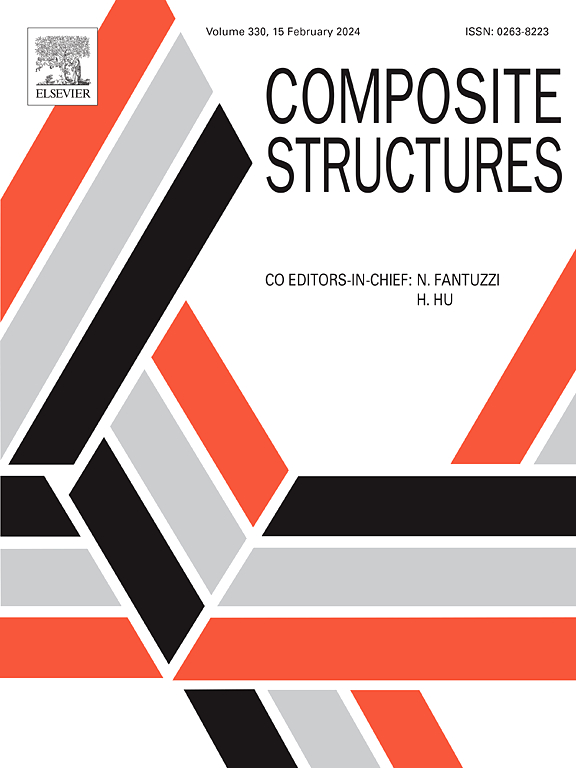Shear performance of GFRP reinforced UHPC short beams
IF 6.3
2区 材料科学
Q1 MATERIALS SCIENCE, COMPOSITES
引用次数: 0
Abstract
This paper investigated experimentally the shear performance of ultra-high-performance concrete (UHPC) deep beams reinforced longitudinally with glass fiber reinforced polymer (GFRP) bars without web reinforcements. Ten beams were cast, in which seven were longitudinally reinforced with GFRP bars, while the remaining three were reinforced with steel bars for comparison. All beams had similar lengths and widths of 2000 mm and 150 mm, respectively, while the depths varied. The test parameters included the effective depth (d), shear span-to-depth ratio (a/d), number of longitudinal bars, and longitudinal reinforcement ratio (ρ). All the GFRP reinforced beams had higher shear capacities and lower post cracking stiffness than their steel counterparts. The experimental results show that varying the test parameters have a significant impact on the shear capacity of the beams. For instance, decreasing the a/d ratio for the GFRP reinforced beams from 1.8 to 1.5 and from 1.8 to 1.1 increased the load carrying capacity by 33 % and 95 %, respectively. The experimental results for the shear capacity were compared against the predictions obtained using the strut and tie method as per the ACI-318–19 and CSA-S806-12 codes. The failure load predictions by the ACI and CSA code showed the same trends as those shown in the experimental results. Moreover, both codes were conservative in predicting the shear capacities.
GFRP 加固超高强度混凝土短梁的剪切性能
本文通过实验研究了用玻璃纤维增强聚合物(GFRP)钢筋纵向加固、无腹板加固的超高性能混凝土(UHPC)深梁的剪切性能。共浇筑了 10 根梁,其中 7 根采用玻璃纤维增强聚合物(GFRP)钢筋纵向加固,其余 3 根采用钢筋加固,以进行对比。所有梁的长度和宽度相似,分别为 2000 毫米和 150 毫米,但深度各不相同。测试参数包括有效深度 (d)、剪切跨度与深度比 (a/d)、纵向钢筋数量和纵向配筋率 (ρ)。与钢梁相比,所有 GFRP 加固梁的抗剪能力都更高,开裂后的刚度都更低。实验结果表明,改变试验参数对梁的抗剪能力有显著影响。例如,将 GFRP 加固梁的 a/d 比值从 1.8 降至 1.5 和从 1.8 降至 1.1,可分别提高 33% 和 95% 的承载能力。剪切能力的实验结果与根据 ACI-318-19 和 CSA-S806-12 规范使用支撑和拉杆方法得出的预测结果进行了比较。ACI 和 CSA 规范预测的破坏荷载与实验结果显示的趋势相同。此外,这两种规范对剪切能力的预测都比较保守。
本文章由计算机程序翻译,如有差异,请以英文原文为准。
求助全文
约1分钟内获得全文
求助全文
来源期刊

Composite Structures
工程技术-材料科学:复合
CiteScore
12.00
自引率
12.70%
发文量
1246
审稿时长
78 days
期刊介绍:
The past few decades have seen outstanding advances in the use of composite materials in structural applications. There can be little doubt that, within engineering circles, composites have revolutionised traditional design concepts and made possible an unparalleled range of new and exciting possibilities as viable materials for construction. Composite Structures, an International Journal, disseminates knowledge between users, manufacturers, designers and researchers involved in structures or structural components manufactured using composite materials.
The journal publishes papers which contribute to knowledge in the use of composite materials in engineering structures. Papers deal with design, research and development studies, experimental investigations, theoretical analysis and fabrication techniques relevant to the application of composites in load-bearing components for assemblies, ranging from individual components such as plates and shells to complete composite structures.
 求助内容:
求助内容: 应助结果提醒方式:
应助结果提醒方式:


